Branding Cities Through Architecture: Identify, Formulate, and Communicate the City Image of Amman, Jordan
Abstract
1. Introduction
2. Literature Review
2.1. City Branding: Theory and Definition
2.2. The City Image and Identity
2.3. City Branding and Dynamics of Urban Imaginary
2.4. The Co-Creation of a City Brand
2.5. Architecture and City Branding
3. Branding Amman and the Paradox of City Identity
4. Research Methodology
5. Results and Discussion
5.1. Identifying the Branding Message
5.1.1. Setting Core Values
5.1.2. Outlining the City Image
5.2. Formulating the City Brand
- -
- Develop a long-term vision for the current situation by recognizing what the city is, what it wants to be, and how to develop it in the future. In addition, a variety of stakeholders should be empowered to warrant continuity and a shared vision guided by strong leadership.
- -
- Agree on a definite set of values attached to the personality of the city and develop a branding message that demonstrates this value based on a clear local perspective.
- -
- Plan a branding strategy that revolves around the city’s true personality addressing both the internal and external audiences.
- -
- Create a dynamic environment through developing urban actions and support a city culture enhanced with design elements that reflect the city’s values and assimilate the diversity of urban imaginaries among people.
- -
- Embrace Amman’s contemporary identity without dismissing its heritage legacy.
- -
- Carry out frequent reviews for branding practices in the city via special branding laws that match the city’s needs, aspirations, and assets.
“Amman is a combination of many contradictory things; ignorance and education, poverty and wealth, new and old, organized and unplanned areas, which reflects on the residents, and makes a sort of segregation where the geographic areas become the identity”.(Journalist)
“We are not sure who we are, and what we want to be. We are just copying from others because we think they are better. Some areas do not feel like Amman but do not even feel like other places…”(Architect)
“Amman presents a combination of images that imitates all other cities in Jordan and presents both the poor and the rich”(Writer)
5.3. Communicating the City Brand
6. Conclusions
Author Contributions
Funding
Institutional Review Board Statement
Informed Consent Statement
Data Availability Statement
Acknowledgments
Conflicts of Interest
References
- Bonakdar, A.; Audirac, I. City planning, urban imaginary, and the branded space: Untangling the role of city plans in shaping Dallas’s urban imaginaries. Cities 2021, 117, 103–115. [Google Scholar] [CrossRef]
- Sevin, H. Understanding Cities through city brands: City branding as a social and semantic network. Cities 2014, 38, 47–56. [Google Scholar] [CrossRef]
- Neamţu, B.; Leuca, C. From Competing Urban Imaginaries to Cohesive City Brands-New Challenges for Local Governments. Transylv. Rev. Adm. Sci. 2007, 3, 73–85. [Google Scholar]
- Gönüllüoğlu, S.; Arslan Selçuk, S. City branding in the context of architecture, tourism, culture, and cultural identity interaction—Bibliometric analysis of literature. Place Brand. Public Dipl. 2024, 21, 189–206. [Google Scholar] [CrossRef]
- Elahi, S. Investigating the role of vernacular architecture as a sustainable and eco-friendly architecture in city branding. In Proceedings of the International Conference of Contemporary Affairs in Architecture and Urbanism-ICCAUA, Online, 11–13 May 2022; Volume 5, pp. 773–778. [Google Scholar]
- Lemmetyinen, A.; Nieminen, L.; Aalto, J. A gentler structure to life: Co-creation in branding a cultural route. Place Brand. Public Dipl. 2021, 17, 268–277. [Google Scholar] [CrossRef]
- Ren, X. Architecture as branding: Mega project developments in Beijing. Built Environ. 2008, 34, 517–531. [Google Scholar] [CrossRef]
- Dinnie, K. Nation Branding: Concepts, Issues, Practice; Routledge: London, UK, 2015. [Google Scholar]
- Dinnie, K. Place branding: Overview of an emerging literature. Place Brand. Public Dipl. 2004, 1, 106–110. [Google Scholar] [CrossRef]
- Prilenska, V. City branding as a tool for urban regeneration: Towards a theoretical framework. Archit. Urban Plan. 2012, 6, 12–16. [Google Scholar] [CrossRef]
- Eugenio-Vela, J.; Ginesta, X.; Kavaratzis, M. The critical role of stakeholder engagement in a place branding strategy: A case study of the Empordà brand. Eur. Plan. Stud. 2020, 28, 1393–1412. [Google Scholar] [CrossRef]
- Zenker, S.; Braun, E. Branding a city: A conceptual approach for place branding and place brand management. In In Proceedings of the 39th European Marketing Academy Conference, Copenhagen, Denmark, 1–4 June 2010. [Google Scholar]
- Kavaratzis, M.; Hatch, M. The dynamics of place brands: An identity-based approach to place branding theory. Mark. Theory 2013, 13, 69–86. [Google Scholar] [CrossRef]
- Oguztimur, S.; Akturan, U. Synthesis of city branding literature (1988–2014) as a research domain. Int. J. Tour. Res. 2016, 18, 357–372. [Google Scholar] [CrossRef]
- Kavaratzis, M. From “necessary evil” to necessity: Stakeholders’ involvement in place branding. J. Place Manag. Dev. 2012, 5, 7–19. [Google Scholar] [CrossRef]
- Muratovski, G. The role of architecture and integrated design in city branding. Place Brand. Public Dipl. 2011, 8, 195–207. [Google Scholar] [CrossRef]
- Pike, A. Geographies of brands and branding. Prog. Hum. Geogr. 2009, 33, 619–645. [Google Scholar] [CrossRef]
- Hakala, U.; Lemmetyinen, A.; Nieminen, L. Rebranding a “rather strange, definitely unique” city via co-creation with its residents. Place Brand. Public Dipl. 2020, 16, 316–325. [Google Scholar] [CrossRef]
- Kavaratzis, M. From city marketing to city branding: Towards a theoretical framework for developing city brands. Place Brand. Public Dipl. 2004, 1, 58–73. [Google Scholar] [CrossRef]
- Kowaas, R.; Syamsia, J.C.; Mandagi, D.W. The antecedents of an effective city branding: A comprehensive systematic review. J. Ekon. 2023, 12, 2178–2186. [Google Scholar]
- Chan, A.; Suryadipura, D.; Kostini, N. City image: City branding and city identity strategies. Rev. Integr. Bus. Econ. Res. 2021, 10, 330–341. [Google Scholar]
- Lynch, K. The Image of the City; MIT Press: Cambridge, MA, USA, 1960. [Google Scholar]
- Hubbard, P.; Hall, T. The entrepreneurial city and the new urban politics. In The Entrepreneurial City: Geographies of Politics, Regime and Representation; Hall, T., Hubbard, P., Eds.; John Wiley Sons Ltd.: Chichester, UK, 1998; pp. 1–23. [Google Scholar]
- Kotler, P.; Haider, D.H.; Rein, I. Marketing Places: Attracting Investment, Industry, and Tourism to Cities, States, and Nations; The Free Press: New York, USA, 1993. [Google Scholar]
- Ashworth, S. Place Promotion: The Use of Publicity and Marketing to Sell Towns and Regions; John Wiley Sons: New York, NY, USA, 1994. [Google Scholar]
- Shirvani Dastgerdi, A.; De Luca, G. Strengthening the city’s reputation in the age of cities: An insight in the city branding theory. City Territ. Archit. 2019, 6, 2. [Google Scholar] [CrossRef]
- Kesseiba, K. Branding Architecture: The logic behind brand promotion of architectural product and iconic buildings in the 21st century. In Proceedings of the ArchCairo8-Conference Proceedings, Cairo, Egypt, 8–10 April 2019. [Google Scholar]
- Vela, J.; Nogué, J.; Govers, R. Visual landscape as a key element of place branding. J. Place Manag. Dev. 2017, 10, 23–44. [Google Scholar] [CrossRef]
- Lucarelli, A. Unravelling the complexity of “city brand equity”: A three-dimensional framework. J. Place Manag. Dev. 2012, 5, 1753–8343. [Google Scholar] [CrossRef]
- Boisen, M.; Terlouw, K.; Groote, P.; Couwenberg, O. Reframing place promotion, place marketing, and place branding-moving beyond conceptual confusion. Cities 2018, 80, 4–11. [Google Scholar] [CrossRef]
- Castillo-Villar, F. Urban icons and city branding development. J. Place Manag. Dev. 2016, 9, 255–268. [Google Scholar] [CrossRef]
- Hatch, M.J.; Schultz, M. The dynamics of organizational identity. Hum. Relat. 2002, 55, 989–1018. [Google Scholar] [CrossRef]
- Mayes, R. A Place in the Sun: The politics of place, identity and branding. Place Brand. Public Dipl. 2008, 4, 124–132. [Google Scholar] [CrossRef]
- Hakala, U. The voice of dwellers–developing a place brand by listening to its residents. J. Place Manag. Dev. 2021, 14, 277–300. [Google Scholar] [CrossRef]
- Lindner, C.; Meissner, M. Urban imaginaries in theory and practice. In The Routledge Companion to Urban Imaginaries; Lindner, C., Meissner, M., Eds.; Routledge: London, UK, 2019. [Google Scholar]
- Kavaratzis, M.; Kalandides, A. Rethinking the place brand: The interactive formation of place brands and the role of participatory place branding. Environ. Plan. A 2015, 47, 1368–1382. [Google Scholar] [CrossRef]
- Soja, E.W. Postmetropolis: Critical Studies of Cities and Regions; Wiley-Blackwell: Hoboken, NJ, USA, 2000. [Google Scholar]
- Kalandides, A. The problem with spatial identity: Revisiting the ‘Sense of Place’. J. Place Manag. Dev. 2011, 4, 28–39. [Google Scholar] [CrossRef]
- Lema, J. The Role of Imaginaries in Shaping Power Relations in Urban Planning Processes. Doctoral Thesis, University of Milano-Bicocca, Milan, Italy, 2022. [Google Scholar]
- Aitken, R.; Campelo, A. The four Rs of place branding. J. Mark. Manag. 2011, 27, 913–933. [Google Scholar] [CrossRef]
- Greenberg, M. Branding cities: A social history of the urban lifestyle. Urban Aff. Rev. 2000, 36, 228–263. [Google Scholar] [CrossRef]
- Baker, B. Strategic Essentials for Place Branding. 2019. Available online: www.Brandingstrategyinsider.com (accessed on 9 April 2023).
- Tøttenborg, A.; Ooi, C.S.; Hardy, A. Place branding through public management lenses: Supplementing the participatory agenda. Place Brand. Public Dipl. 2023, 19, 114–127. [Google Scholar] [CrossRef]
- Golestaneh, S.H. Human-Centered Place Branding: An Integrated Approach to Place Branding. Doctoral Thesis, Universidade do Algarve, Faro, Portugal, 2021. [Google Scholar]
- Belabas, W. Glamour or sham? Residents’ perceptions of city branding in a super-diverse city: The case of Rotterdam. Cities 2023, 137, 104323. [Google Scholar] [CrossRef]
- Sklair, L. Iconic architecture and the culture-ideology of consumerism. Theory Cult. Soc. 2010, 27, 135–159. [Google Scholar] [CrossRef]
- Riza, M.; Doratli, N.; Fasli, M. City branding and identity. Procedia-Soc. Behav. Sci. 2012, 35, 293–300. [Google Scholar] [CrossRef]
- Muratovski, G. Urban Branding: The Politics of Architecture; Common Ground Publishing: Champaign, IL, USA, 2013. [Google Scholar]
- Parkerson, B.; Saunder, J. City branding: Can goods and services branding models be used to brand cities? Place Brand. Public Dipl. 2005, 1, 242–264. [Google Scholar] [CrossRef]
- Alzouby, A.; Obeidat, B.; Tanash, S. Significant dimensions in the process of determining the city branding. Theor. Empir. Res. Urban Manag. 2023, 18, 27–51. [Google Scholar]
- McNeill, D.; Tewdwr-Jones, M. Architecture, banal nationalism and re-territorialization. Int. J. Urban Reg. Res. 2003, 27, 738–743. [Google Scholar] [CrossRef]
- Kirby, A.; Kent, A. Architecture as brand: Store design and brand identity. J. Prod. Brand Manag. 2010, 19, 432–439. [Google Scholar] [CrossRef]
- Brauer, G. Architecture as Brand Communication; Birkhauser: Basel, Switzerland, 2002. [Google Scholar]
- Polay, M. Architectural Images and City Marketing. In Neo-Liberalism and the Architecture of the Post Professional Era; Springer: Cham, Switzerland, 2018; pp. 151–155. [Google Scholar]
- Jencks, C. The Iconic Building; Rizzoli: New York, NY, USA, 2005. [Google Scholar]
- Chung, C.; Inaba, J.; Koolhaas, R.; Leong, S. Harvard Design School Guide to Shopping; Taschen: London, UK, 2001. [Google Scholar]
- Qashmar, D. The dialectical dimensions of architectural identity in heritage conservation (The Case of Amman). Arts Des. Stud. 2018, 61, 14–22. [Google Scholar]
- Abu-Dayyeh, N. Amman: The past and the future of modern Arab capitals. Les Cah. L’Orient 2004, 75, 125–138. [Google Scholar]
- Ababsa, M. Atlas of Jordan: History, Territories and Society; Presses de l’Ifpo, Institut français du Proche-Orient: Beirut, Lebanon, 2013. [Google Scholar]
- El-Abed, A. City Migration Profile—Greater Amman Municipality; International Centre for Migration Policy Development (ICMPD): Vienna, Austria, 2017. [Google Scholar]
- Rababe’h, S. Nabataean architectural identity and its impact on contemporary architecture in Jordan. Dirasat Eng. Sci. 2010, 37, 27–53. [Google Scholar]
- Dahabreh, S. Trends in the contemporary architecture of Amman. Int. J. Eng. Res. Technol. 2020, 13, 1658–1670. [Google Scholar] [CrossRef]
- Musa, M. Constructing Global Amman: Petrodollars, Identity, and the Built Environment in the Early Twenty-First Century. Doctoral Thesis, University of Illinois at Urbana, Champaign, IL, USA, 2014. [Google Scholar]
- Alhusban, A.; Alhusban, S. Re-locating the identity of Amman’s city through the hybridization process. J. Place Manag. Dev. 2020, 14, 81–113. [Google Scholar] [CrossRef]
- Jarrar, O. Cultural Influences in Jordanian Architectural Practices: Post 1990. Doctoral Thesis, University of Calgary, Calgary, AB, Canada, 2013. [Google Scholar]
- Zalloom, B. The Effects of Technological Aspects on the Formation and Transformation of Cities: The Case of Amman. Eurasia Proc. Sci. Technol. Eng. Math. 2023, 26, 202–207. [Google Scholar] [CrossRef]
- Atiyat, D. The Image of Amman City: Structure, Identity, and Meaning. Int. J. Sustain. Dev. Plan. 2022, 17, 1931–1935. [Google Scholar] [CrossRef]
- Daher, R. Tourism in the Middle East: Continuity, Change and Transformation; Channel View Publications: London, UK, 2007. [Google Scholar]
- Khirfan, L.; Momani, B. (Re)branding Amman: A ‘lived’ city’s values, image and identity. Place Brand. Public Dipl. 2013, 9, 49–65. [Google Scholar] [CrossRef]
- Ali, N.; Al-Khafaji, S. Branding as an identity of place in contemporary cities. Int. J. Health Sci. 2022, 6, 12213–12228. [Google Scholar] [CrossRef]
- Majzoub, R.; Tawil, M.; Abuhassan, L. Investigating brand archetypes: Unveiling the perceived image of Jabal Al-Weibdeh neighborhood. Place Brand. Public Dipl. 2024, 21, 207–222. [Google Scholar] [CrossRef]
- Alraouf, A. Towards a new paradigm in city branding and marketing: The case of Doha, Qatar. In Proceedings of the 55th International Society of City and Regional Planners (ISOCARP) World Planning Congress, Jakarta-Bogor, Indonesia, 9–13 September 2019; pp. 1920–1936. [Google Scholar]
- Jelincic, D.; Vukic, F.; Kostesic, I. The city is more than just a destination: An insight into city branding practices in Croatia. Sociol. Prost. 2017, 207, 117–134. [Google Scholar]
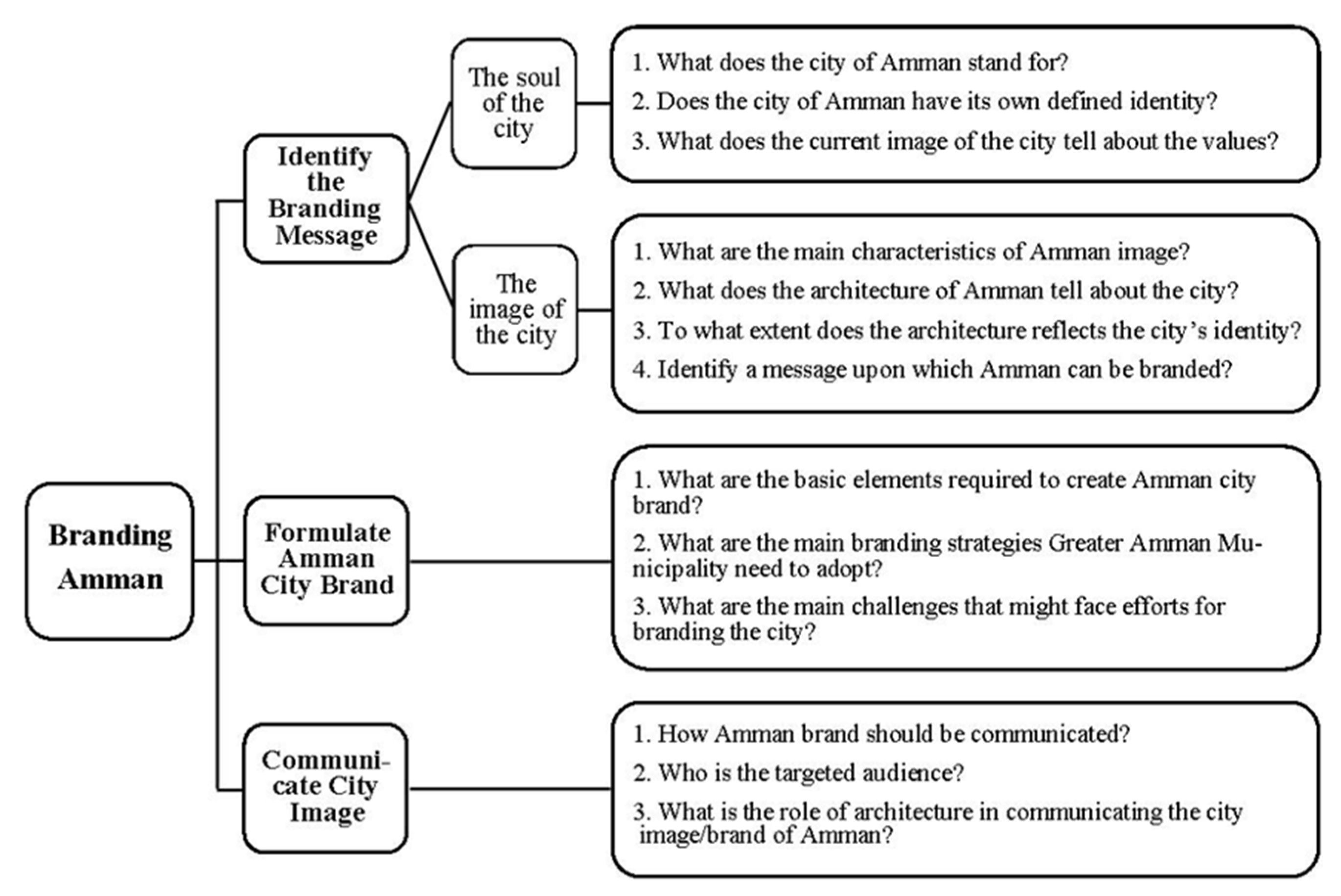
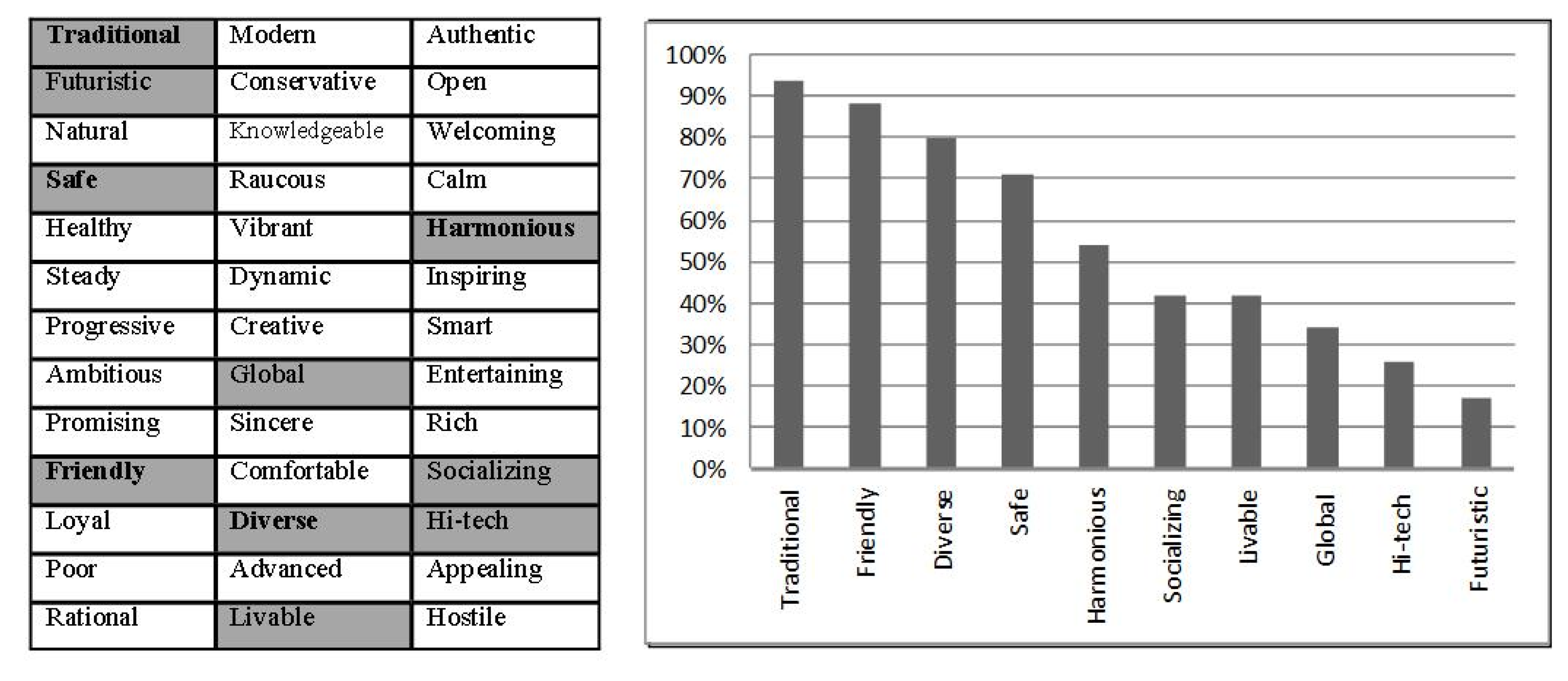
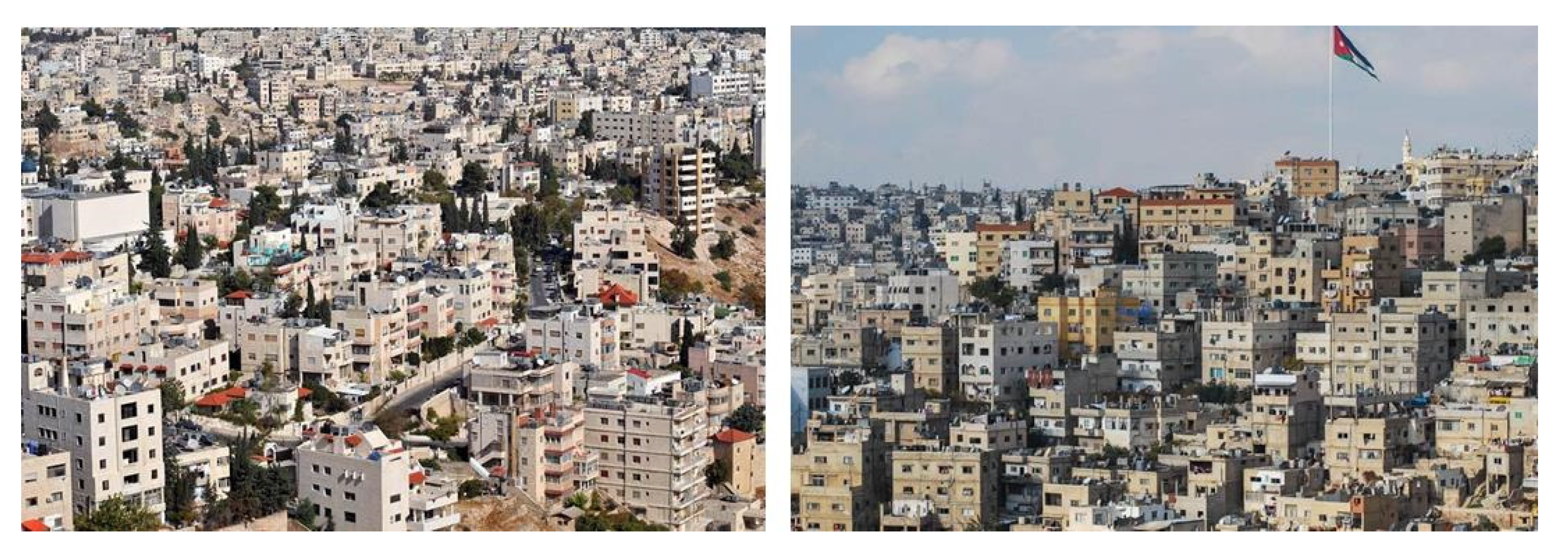
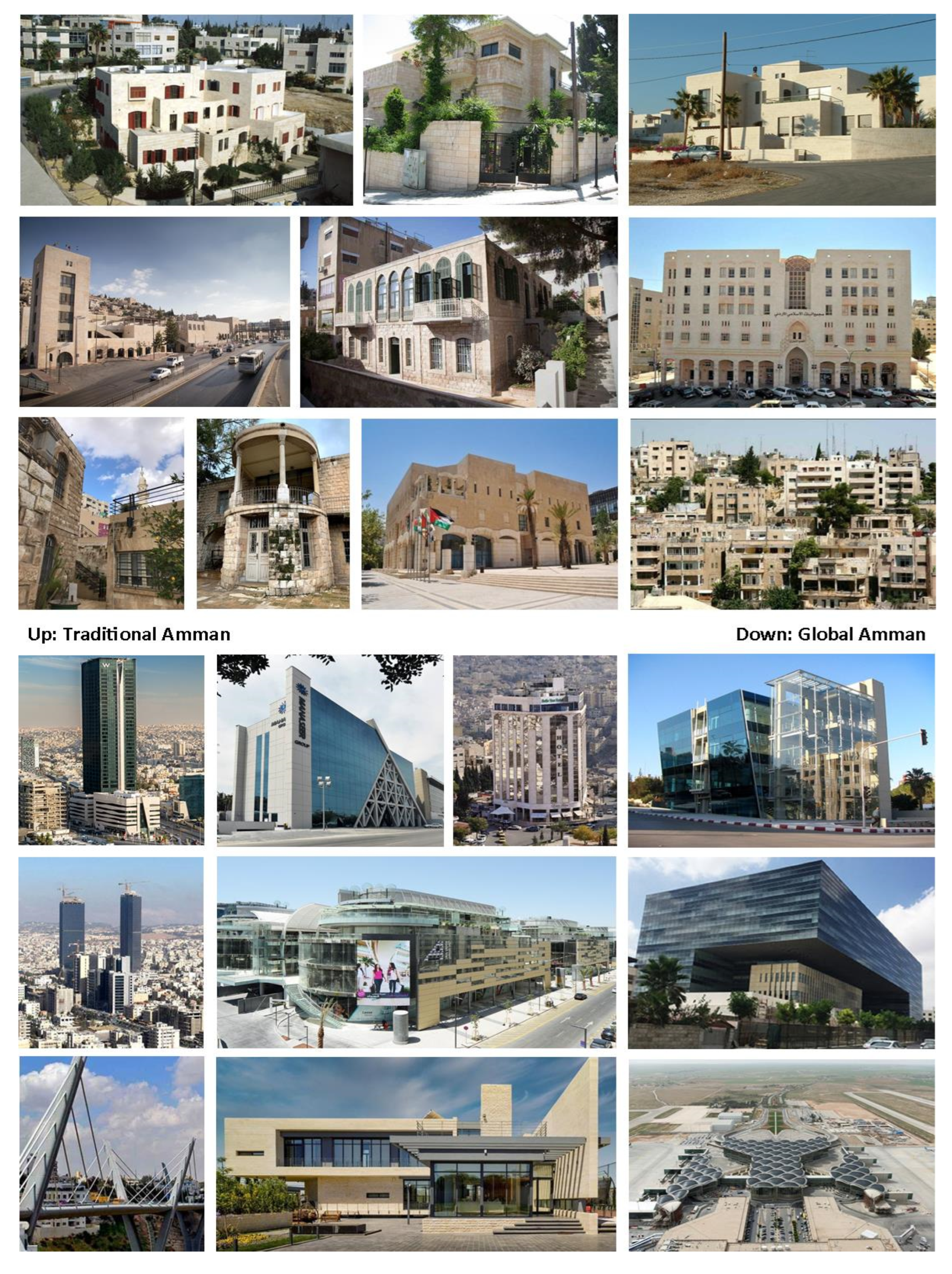
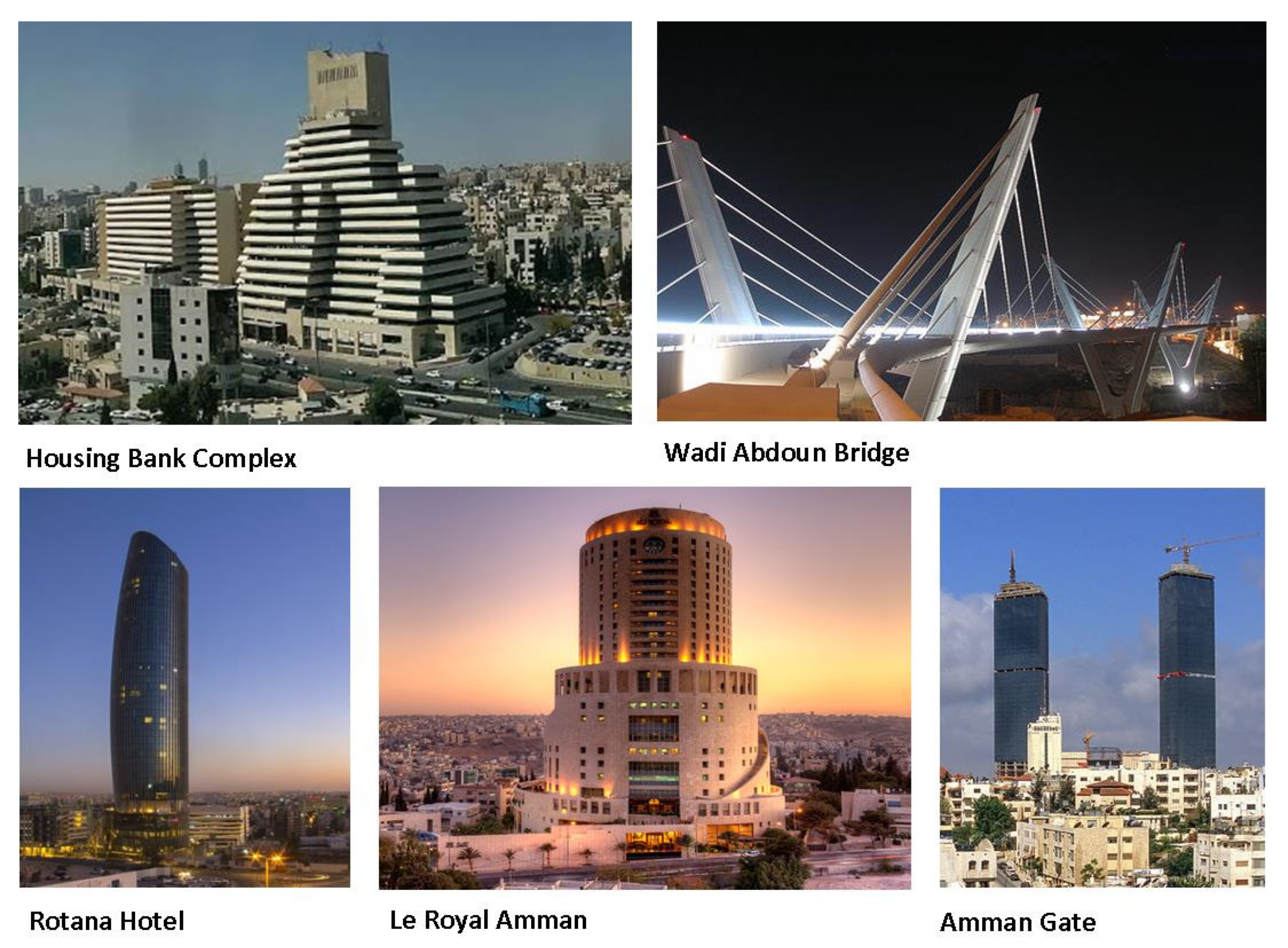
| Challenges | Type of Challenge | Answers Percentage |
|---|---|---|
| 1. Disagreement on the need to brand Amman | Cultural | 95% |
| 2. The lack of an evident approach to brand the city | Administrative | 70% |
| 3. Contradictory perceptions of the city image | Cultural | 10% |
| 4. The absence of a defined architectural identity | Architectural | 80% |
| 5. Amman’s image has no clear message | Architectural | 77% |
| 6. Inadequate laws and regulations | Legislative | 67% |
| 7. Infrastructure and public facilities | Architectural | 95% |
| 8. Economic determinants | Economic | 75% |
| 9. The absence of proper communication tools | Cultural | 65% |
| 10. Inconsistencies in the city plan | Legislative | 93% |
| 11. The variety of styles and disorganized construction | Architectural | 87% |
| 12. Missing landmarks | Architectural | 96% |
| 13. The gap between planning and implementation | Cultural | 70% |
Disclaimer/Publisher’s Note: The statements, opinions and data contained in all publications are solely those of the individual author(s) and contributor(s) and not of MDPI and/or the editor(s). MDPI and/or the editor(s) disclaim responsibility for any injury to people or property resulting from any ideas, methods, instructions or products referred to in the content. |
© 2025 by the authors. Licensee MDPI, Basel, Switzerland. This article is an open access article distributed under the terms and conditions of the Creative Commons Attribution (CC BY) license (https://creativecommons.org/licenses/by/4.0/).
Share and Cite
Al-Betawi, Y.N.; Abu Ehmaid, H.B. Branding Cities Through Architecture: Identify, Formulate, and Communicate the City Image of Amman, Jordan. Architecture 2025, 5, 50. https://doi.org/10.3390/architecture5030050
Al-Betawi YN, Abu Ehmaid HB. Branding Cities Through Architecture: Identify, Formulate, and Communicate the City Image of Amman, Jordan. Architecture. 2025; 5(3):50. https://doi.org/10.3390/architecture5030050
Chicago/Turabian StyleAl-Betawi, Yamen N., and Heba B. Abu Ehmaid. 2025. "Branding Cities Through Architecture: Identify, Formulate, and Communicate the City Image of Amman, Jordan" Architecture 5, no. 3: 50. https://doi.org/10.3390/architecture5030050
APA StyleAl-Betawi, Y. N., & Abu Ehmaid, H. B. (2025). Branding Cities Through Architecture: Identify, Formulate, and Communicate the City Image of Amman, Jordan. Architecture, 5(3), 50. https://doi.org/10.3390/architecture5030050





